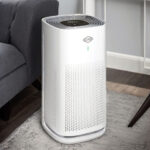Welcome to our comprehensive guide on Indoor air quality (IAQ), an often overlooked aspect of our daily lives that plays a crucial role in our overall health and well-being. This blog post aims to shed light on what indoor air quality is, its importance, and how it affects us in both the short and long term. Whether you’re at home, in the office, or any indoor environment, the air you breathe can significantly impact your health. Let’s dive into the world of IAQ and understand its intricacies.
What is Indoor Air Quality?
Indoor air quality refers to the air quality within and around buildings and structures, especially as it relates to the health and comfort of building occupants. Understanding and controlling common pollutants indoors can help reduce your risk of indoor health concerns. Air quality indoors can be influenced by a variety of factors such as pollutants, ventilation, humidity levels, and temperature.
We spend a significant amount of our time indoors. According to the Environmental Protection Agency (EPA), the average American spends approximately 90% of their time indoors, where the concentrations of some pollutants are often 2 to 5 times higher than typical outdoor concentrations.

The primary elements that determine indoor air quality are air pollutants and particulate matter. Air pollutants refer to substances in the air that can cause harm to humans and the environment. They can be either natural or man-made and include things like dust, pollen, pet dander, mold spores, smoke and other particulates.
On the other hand, particulate matter, also known as PM, includes small particles and liquid droplets suspended in air. This could consist of a variety of compounds including nitrates, sulfates, organic chemicals, metals, soil or dust particles, and allergens. When these particulates are breathed in, they can affect the heart and lungs and cause serious health effects.
Poor indoor air quality can lead to immediate and long-term health issues, ranging from irritation of the eyes, nose, and throat, to more serious chronic conditions such as respiratory diseases, heart disease, and cancer. Therefore, understanding and improving the quality of the air we breathe indoors is crucial for our health and well-being.
In recent years, energy conservation measures have led to airtight building construction that can create problems with indoor air quality. Less air circulation means pollutants can build up over time, affecting the health of the building’s occupants. Furthermore, modern lifestyles have introduced a variety of synthetic materials and chemicals into our living spaces, contributing to a diverse range of indoor pollutants.
In this guide, we will explore the different aspects of indoor air quality in detail. We will discuss the immediate and long-term health effects of poor indoor air quality, identify primary causes of indoor air quality problems, delve into the specifics of indoor air pollution, and provide strategies for improving indoor air quality. Our goal is to empower you with the knowledge to create a healthier indoor environment for yourself and your loved ones.
Immediate Health Effects of Poor Indoor Air Quality
Continuing our exploration of Indoor Air Quality (IAQ), it’s crucial to understand the immediate effects that poor air quality can have on our health. Unlike long-term effects that develop over time, immediate effects can be experienced shortly after exposure to pollutants in the indoor environment. These effects can range from mild discomfort to severe reactions, depending on various factors such as the type of pollutant, concentration levels, and individual susceptibility.
Common Symptoms of Poor IAQ
The immediate symptoms associated with poor indoor air quality are often similar to those of colds or other viral diseases, making it challenging to pinpoint the exact cause. Common symptoms include:
- Irritation of the Eyes, Nose, and Throat: This is often the first sign of poor air quality. Irritants in the air can cause dryness, itchiness, or a burning sensation in these areas.
- Headaches: Exposure to certain pollutants like volatile organic compounds (VOCs) and carbon monoxide can lead to headaches, which may range from mild to severe.
- Dizziness and Fatigue: Poor air quality can lead to feelings of dizziness and general fatigue, which can affect concentration and productivity.
- Allergic Reactions: People with allergies may experience heightened symptoms such as sneezing, nasal congestion, and skin rashes.
Identifying the Source
Identifying the immediate health effects of poor indoor air quality can be difficult, as these symptoms are often non-specific and can be mistaken for those of other illnesses. However, a key indicator is a noticeable relief of symptoms when leaving the affected indoor environment.
Risk Groups
Certain groups of people are more susceptible to the immediate effects of indoor air pollutants. These include:
- Individuals with Asthma or Allergies: These individuals are more likely to experience exacerbated symptoms in response to indoor air pollutants.
- Children and the Elderly: Due to their developing or weakened immune systems, children and the elderly are more vulnerable to the effects of poor air quality.
- People with Pre-existing Respiratory or Cardiovascular Conditions: Such individuals are at a higher risk of experiencing adverse health effects from indoor air pollutants.
What Can You Do?
If you suspect that your symptoms are related to indoor air quality, consider the following steps:
- Increase Ventilation: Proper ventilation plays a critical role in mitigating the immediate effects of poor indoor air quality. Inadequate ventilation can lead to an accumulation of pollutants, exacerbating the health issues mentioned above. Open windows or use fans to increase air circulation.
- Houseplants: Another natural method to improve indoor air quality involves integrating houseplants into your living space. Several studies have indicated that certain species of plants can act as natural air purifiers. Plants like Spider Plant, English Ivy, and Peace Lily are not just aesthetically pleasing but also absorb toxins, producing fresh oxygen in return.
- Identify and Eliminate Sources: Look for potential sources of indoor air pollution like tobacco smoke, mold, or chemical products and take steps to reduce or eliminate them.
- Regular Cleaning: Regular cleaning is another key strategy in maintaining optimal indoor air quality. Dust and dirt often carry harmful particles which can pollute the air. By vacuuming regularly, washing linens, and keeping surfaces dust-free, you can drastically reduce pollutants inside your home.
- Monitor Humidity Levels: High humidity can contribute to mold growth and dust mites. Maintaining a humidity level between 30-50% can help control allergens.

Long-Term Health Effects of Indoor Air Pollution
After discussing the immediate health effects of poor indoor air quality, it’s vital to address the long-term consequences. Chronic exposure to indoor air pollutants can lead to significant health problems that may not become apparent until years after exposure. These effects can range from chronic respiratory diseases to heart disease and even cancer. Understanding these risks is key to advocating for better air quality in our living and working environments.
Chronic Respiratory Diseases
One of the most significant long-term effects of poor indoor air quality is the development of chronic respiratory diseases. Prolonged exposure to pollutants like tobacco smoke, particulate matter, and certain chemicals can lead to conditions such as:
- Chronic Obstructive Pulmonary Disease (COPD): A group of lung diseases that block airflow and make it difficult to breathe.
- Asthma: For individuals with asthma, long-term exposure to indoor air pollutants can lead to an increase in the frequency and severity of asthma attacks.
- Lung Cancer: Certain air pollutants, like radon and asbestos fibers, are known carcinogens that can increase the risk of lung cancer.
Cardiovascular Problems
Indoor air pollution can also affect the cardiovascular system. Pollutants like carbon monoxide and particulate matter can contribute to:
- Heart Disease: Long-term exposure can lead to an increased risk of heart attacks and other cardiovascular diseases.
- Hypertension (High Blood Pressure): Chronic exposure to certain air pollutants has been linked to higher blood pressure, a risk factor for heart disease.
Neurological Effects
Emerging research suggests that long-term exposure to certain indoor air pollutants may have neurological effects. For instance, exposure to high levels of certain VOCs and particulate matter may be linked to:
- Cognitive Decline: Studies indicate that prolonged exposure to air pollution may be associated with a decrease in cognitive function.
- Mental Health Issues: There is increasing evidence that air quality may impact mental health, with links being drawn to conditions like depression and anxiety.
Cancer Risk
Certain pollutants found indoors, such as asbestos, radon, and tobacco smoke, are known carcinogens. Long-term exposure to these can significantly increase the risk of developing various types of cancer.
Reproductive and Developmental Effects
Exposure to certain indoor air pollutants during pregnancy has been linked to adverse reproductive and developmental health outcomes, including:
- Low Birth Weight
- Preterm Birth
- Developmental Delays
Prevention and Mitigation
While the long-term effects of poor indoor air quality are concerning, there are ways to reduce risk:
- Regular Testing: Test your home for radon, a leading cause of lung cancer.
- Eliminate or Reduce Pollutant Sources: Remove or seal sources of asbestos, reduce the use of VOC-emitting products, and prohibit indoor smoking.
- Maintain Proper Ventilation: Ensure adequate ventilation, especially in areas where pollutants are more likely to be present.
Primary Causes of Indoor Air Quality Problems
Having discussed the immediate and long-term health effects of poor indoor air quality, it’s now important to identify the primary causes of indoor air quality problems. Understanding these sources is the first step in mitigating their impact and improving the air we breathe indoors. Indoor air quality can be compromised by a variety of factors, ranging from everyday household activities to structural issues within a building.
Biological Contaminants
One of the major sources of indoor air pollution comes from biological contaminants, which include:
- Mold and Mildew: These thrive in damp, humid conditions and can release spores into the air.
- Dust Mites: Common in bedding, upholstered furniture, and carpets, dust mites are a significant allergen for many people.
- Pet Dander: Skin flakes, hair, and saliva from pets can contribute to indoor air pollution.
- Pollen: Can enter homes through open windows and doors, affecting those with allergies.
Chemical Pollutants
Various chemical pollutants also play a significant role in indoor air quality issues:
- Volatile Organic Compounds (VOCs): Found in paints, varnishes, cleaning supplies, and air fresheners, VOCs can off-gas into the air, causing various health issues.
- Formaldehyde: Often found in pressed wood products, insulation, and some fabrics.
- Carbon Monoxide and Nitrogen Dioxide: These gases can come from improperly vented furnaces, stoves, or gas heaters.
Combustion Products
Incomplete combustion in household appliances can lead to indoor air pollution:
- Tobacco Smoke: Contains a myriad of harmful chemicals and is a major indoor air pollutant.
- Wood-burning Stoves and Fireplaces: Can release particulate matter and carbon monoxide.
Building Materials and Furnishings
Certain building materials and furnishings can emit various pollutants:
- Asbestos: Found in older buildings in insulation, ceiling tiles, and other materials.
- Lead Particles: From lead-based paints, primarily in older homes.
- Radon: A naturally occurring radioactive gas that can enter homes through cracks in the foundation.
Outdoor Air Pollution
Indoor air quality can also be affected by outdoor air pollution, which can enter through windows, doors, and ventilation systems. This includes:
- Industrial Emissions
- Vehicle Exhaust
- Pesticides
Inadequate Ventilation
Poor ventilation can exacerbate indoor air pollution by not allowing indoor pollutants to be diluted or removed.
Understanding Indoor Air Pollution
Now that we have identified the primary causes of indoor air quality problems, let’s delve deeper into understanding indoor air pollution. This section will explore the different types of pollutants, how they affect indoor air quality, and the ways in which they can impact our health. A clear understanding of these elements is crucial for effectively addressing and mitigating indoor air pollution.
Types of Indoor Air Pollutants
Indoor air pollution comprises a variety of contaminants. These can be broadly categorized into:
- Particulate Matter (PM): This includes dust, pollen, pet dander, and smoke particles. PM can be classified by size, with PM2.5 (particles smaller than 2.5 micrometers) being particularly harmful due to their ability to penetrate deep into the lungs.
- Gaseous Pollutants: This group includes VOCs, carbon monoxide, nitrogen dioxide, and ozone. These gases can emanate from combustion processes, building materials, and household products.
- Biological Contaminants: Mold, bacteria, viruses, pollen, and dust mites fall into this category. They thrive in damp or humid environments and can be particularly problematic for individuals with allergies or asthma.
- Radon: A colorless, odorless radioactive gas that comes from the natural breakdown of uranium in soil, rock, and water, and can enter homes through cracks and openings.
Sources and Health Impacts
- Particulate Matter: Sources include smoking, cooking, burning candles, and outdoor pollution entering the home. Health impacts can range from respiratory irritation to more serious conditions like heart and lung diseases.
- Gaseous Pollutants: Commonly come from household products, building materials, and combustion appliances. Exposure can lead to a variety of health issues, including respiratory problems, headaches, and in extreme cases, carbon monoxide poisoning.
- Biological Contaminants: These can accumulate in areas with high humidity or water damage. Health impacts include allergic reactions, asthma exacerbation, and in some cases, infectious diseases.
- Radon: Since it is not detectable by human senses, testing is the only way to determine its presence. Long-term exposure to high levels of radon can lead to lung cancer.
Measuring and Assessing Indoor Air Quality
Assessing indoor air quality involves measuring the concentrations of various pollutants. This can be done using air quality monitors that detect particulate matter, VOCs, and other pollutants. Regular testing for radon is also recommended, especially in areas known for high radon levels.
The Role of Ventilation and Filtration
Improving ventilation is a key strategy in reducing indoor air pollution. This includes opening windows, using exhaust fans, and ensuring that HVAC systems are properly maintained. Air filtration systems and air purifiers can also play a significant role in removing pollutants from indoor air.
Strategies for Improving Indoor Air Quality
Having explored the various aspects and impacts of indoor air pollution, we now turn our attention to the practical strategies for improving indoor air quality. Whether you’re dealing with specific pollutants or looking to enhance the overall air quality in your home or workplace, these strategies can help create a healthier and more comfortable indoor environment.
Enhancing Ventilation
- Natural Ventilation: Regularly open windows and doors to allow fresh air to circulate, reducing the concentration of indoor pollutants.
- Use of Exhaust Fans: Install and use exhaust fans, especially in high-moisture areas like kitchens and bathrooms, to remove pollutants at their source.
- Proper Maintenance of HVAC Systems: Ensure that heating, ventilation, and air conditioning systems are regularly serviced and filters are replaced as needed.
Reducing Pollutant Sources
- Smoke-Free Environment: Enforce a no-smoking policy inside homes and buildings to eliminate tobacco smoke, a major indoor air pollutant.
- Control Humidity Levels: Use dehumidifiers and air conditioners to maintain indoor humidity levels between 30-50% to prevent mold growth.
- Safe Storage and Use of Chemicals: Store household chemicals, paints, and solvents in well-ventilated areas and use them according to manufacturer instructions.
Using Air Purifiers
- Selection of Appropriate Air Purifiers: Choose air purifiers that are effective against the specific pollutants in your home. HEPA filters are particularly good at capturing particulate matter, while activated carbon filters can absorb VOCs and odors.
- Regular Maintenance: Regularly clean and replace filters in your air purifiers to ensure their effectiveness.
Regular Cleaning and Maintenance
- Dust and Vacuum Regularly: Use a vacuum cleaner with a HEPA filter and dust with a damp cloth to reduce the accumulation of particulate matter.
- Control Allergens: Wash bedding regularly and use allergen-proof mattress and pillow covers to reduce exposure to dust mites.
- Periodic Radon Testing: Test your home for radon, particularly if you live in an area known for high radon levels.
Incorporating Plants
- Indoor Plants: Some indoor plants can help improve air quality by absorbing certain pollutants, though their overall effectiveness is subject to debate.
Educating and Raising Awareness
- Awareness and Education: Educate family members and colleagues about the importance of good indoor air quality and the steps they can take to help maintain it.
Conclusion
As we wrap up our comprehensive guide on indoor air quality, it’s important to reflect on the key insights and takeaways. Indoor air quality is a crucial aspect of our living and working environments that directly impacts our health, comfort, and well-being. Through this guide, we’ve explored the various facets of indoor air quality, from understanding the immediate and long-term health effects of poor air quality to identifying its primary causes and implementing strategies for improvement.
Key Takeaways
- Health Impacts Are Significant: Both immediate and long-term health effects of poor indoor air quality can be significant, affecting our respiratory, cardiovascular, and neurological systems.
- Various Sources of Pollution: Indoor air pollution arises from a variety of sources including biological contaminants, chemical pollutants, combustion products, and outdoor air pollution.
- Proactive Measures Are Essential: Regular maintenance, proper ventilation, and reducing pollutant sources are key to improving indoor air quality.
- Awareness and Education: Understanding the causes and effects of indoor air pollution is the first step toward creating healthier indoor environments.
Moving Forward
Improving indoor air quality is a continuous process that requires awareness, effort, and the implementation of effective strategies. By making informed choices about our indoor environments and taking proactive measures, we can significantly enhance the quality of the air we breathe indoors.
Remember, the air quality inside our homes and workplaces is just as important as the air outside. By taking steps to improve indoor air quality, we are investing in our health and the health of those around us.






